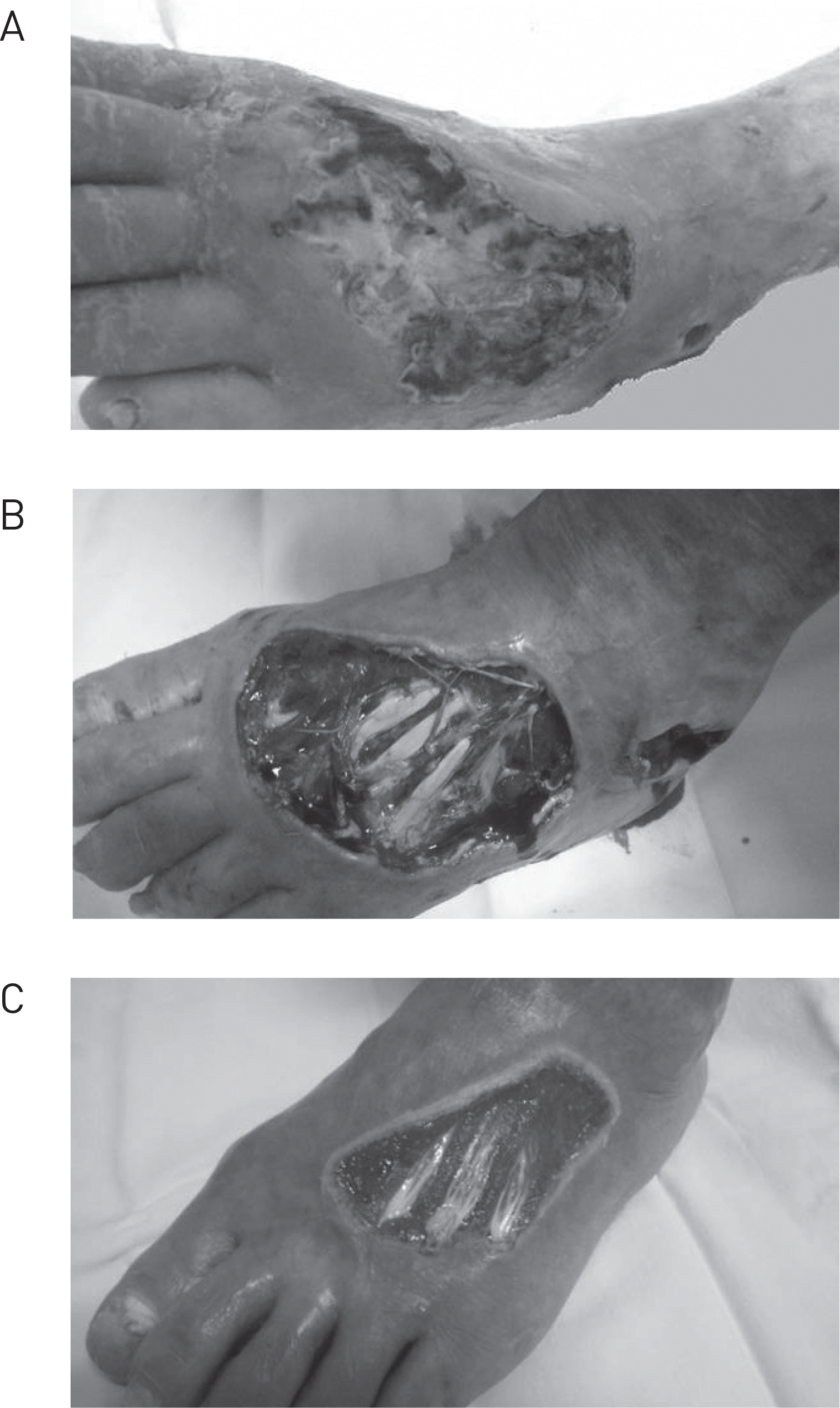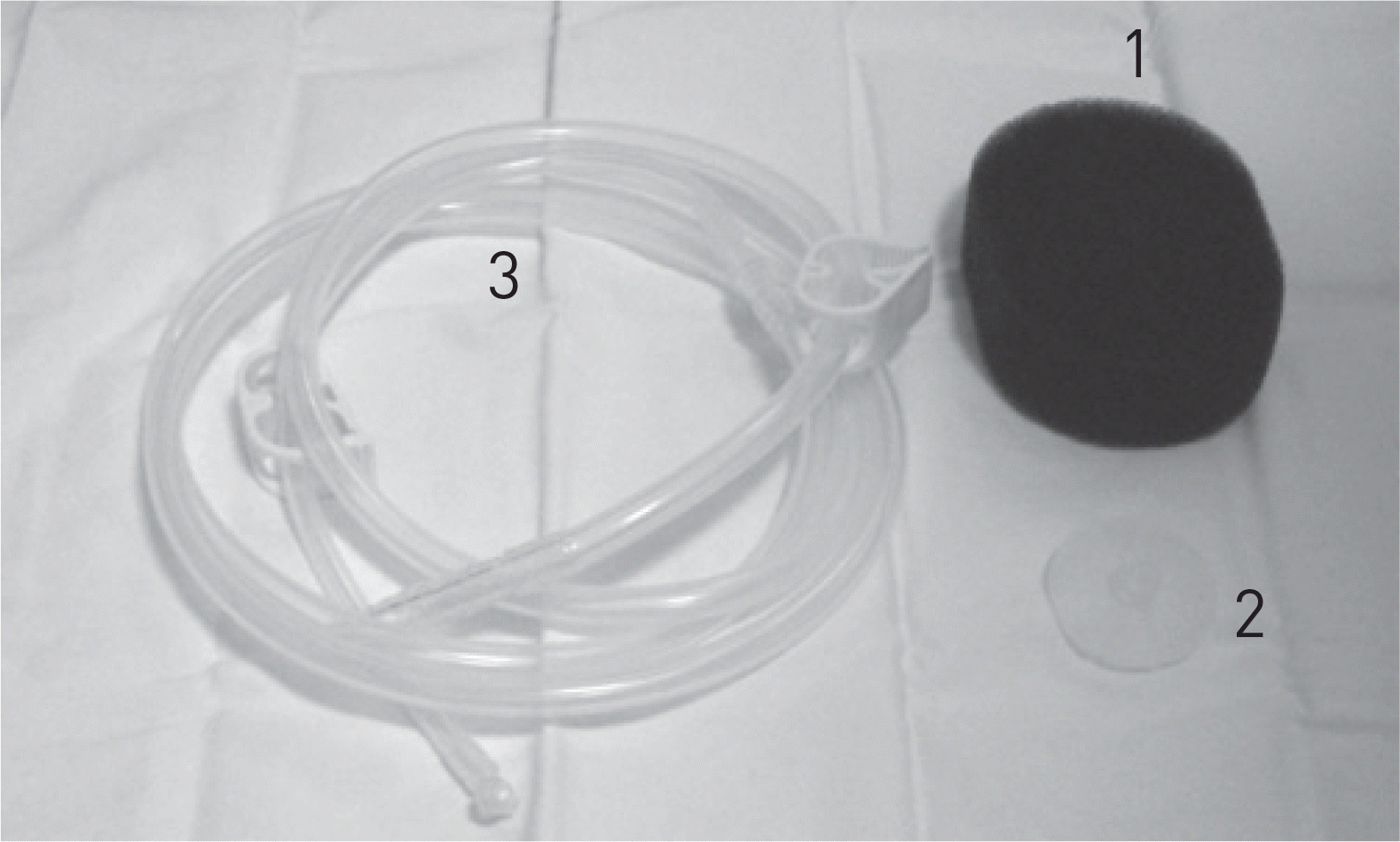Abstract
Diabetic foot ulcers (DFU) are common and serious complications of diabetes mellitus. The prognosis of DFU may be very poor even during early stages depending on the general conditions of patients, and amputation is often required to manage DFU. Various therapeutic approaches to DFU have been introduced, and among these negative-pressure wound therapy using vacuum-assisted closure (VAC-NPWT) is particularly noteworthy. We performed VAC-NPWT in three patients with complicated DFU. We used a modified VAC-NPWT protocol, which used wall suction and curaVAC®. Dressing changes were performed every week, which was longer than standard method. All of our cases improved with granulating wound beds and were cleared of bacterial infection by the end of modified VAC therapy. These modifications reduced the costs of VAC-NPWT without introducing associated side effects. We recommend the active application of VAC-NPWT for complicated DFU, although this recommendation should be confirmed by large randomized controlled studies.
Go to : 
REFERENCES
1. Boulton AJ, Vileikyte L, Ragnarson-Tennvall G, Apelqvist J. The global burden of diabetic foot disease. Lancet. 2005; 366:1719–24.

2. Most RS Sinnock P. The epidemiology of lower extremity amputations in diabetic individuals. Diabetes Care. 1983; 6:87–91.
3. Ramsey SD, Newton K, Blough D, McCulloch DK, Sandhu N, Reiber GE, Wagner EH. Incidence, outcomes, and cost of foot ulcers in patients with diabetes. Diabetes Care. 1999; 22:382–7.

4. Mayfield JA, Reiber GE, Nelson RG, Greene T. A foot risk classification system to predict diabetic amputation in Pima Indians. Diabetes Care. 1996; 19:704–9.

5. Argenta LC Morykwas MJ. Vacuum-assisted closure: a new method for wound control and treatment: clinical experience. Ann Plast Surg. 1997; 38:563–76.
06. Blume PA, Walters J, Payne W, Ayala J, Lantis J. Comparison of negative pressure wound therapy using vacuum-assisted closure with advanced moist wound therapy in the treatment of diabetic foot ulcers: a multicenter randomized controlled trial. Diabetes Care. 2008; 31:631–6.

7. Armstrong DG Lavery LA. Negative pressure wound therapy after partial diabetic foot amputation: a multicentre, randomised controlled trial. Lancet. 2005; 366:1704–10.
8. Eginton MT, Brown KR, Seabrook GR, Towne JB, Cambria RA. A prospective randomized evaluation of negative-pressure wound dressings for diabetic foot wounds. Ann Vasc Surg. 2003; 17:645–9.

9. Bok SK, Yoon JM, Jo KJ, Oh SH, Hong JH, Lee YJ, Kim YM. The effect of vacuum-assisted closure (V.A.C.) therapy in pressure ulcer. J Korean Acad Rehabil Med. 2005; 29:128–34.
10. Lee KB, Choi J, Moon ES, Yoon TR, Lim KY. Negative pressure wound therapy for traumatic soft tissue defects. J Korean Fract Soc. 2006; 19:67–71.

11. Bae SY, Lee CW, Seo IS. Wall-suction assisted vacuum sealing for treatment of infected diabetic foot ulcer. J Korean Foot Ankle Soc. 2004; 8:26–30.
12. Lee JH, Yang HJ. Application of medifoam B(R) & negative pressure therapy for the auxiliary treatment of pressure sore. J Korean Soc Plast Reconstr Surg. 2004; 31:733–6.
13. Park MC, Lee IJ, Lee JH. Simple and effective negative pressure therapy in chronic wound. J Korean Soc Plast Reconst Surg. 2002; 29:583–7.
14. Morykwas MJ, Argenta LC, Shelton-Brown EI, McGuirt W. Vacuum-assisted closure: a new method for wound control and treatment: animal studies and basic foundation. Ann Plast Surg. 1997; 38:553–62.
15. Shirakawa M, Isseroff RR. Topical negative pressure devices: use for enhancement of healing chronic wounds. Arch Dermatol. 2005; 141:1449–53.
16. Smith N. The benefits of VAC therapy in the management of pressure ulcers. Br J Nurs. 2004; 13:1359–65.

18. Clare MP, Fitzgibbons TC, McMullen ST, Stice RC, Hayes DF, Henkel L. Experience with the vacuum assisted closure negative pressure technique in the treatment of non-healing diabetic and dysvascular wounds. Foot Ankle Int. 2002; 23:896–901.

19. V.A.C.therapy clinical guidelines. A reference source for clinicians. San Antonio, Tx: Kinetic Concepts Inc.;2007.
20. Stawicki SP, Grossman M. "Stretching" negative pressure wound therapy: can dressing change interval be extended in patients with open abdomens? Ostomy Wound Manage. 2007; 53:26–9.
Go to : 
 | Fig. 1.Wound status of patient no.2. (A) Pre-debridement. (B) Post-debridement. (C) Post-vacuum-assisted closure therapy, after 5 weeks. |
 | Fig. 2.Materials used in the application of vacuum-assisted closure therapy include a polyurethane foam (1), suction head (2) and non-collapsible tube (3). |
Table 1.
Summary of clinical characteristics, wound states and VAC-NPWT settings of patients
VAC, vacuum-assisted closure; NPWT, negative-pressure wound therapy; NPDR, non-proliferative diabetic retinopathy; PDR, proliferative diabetic retinopathy; WBC, white blood cell; hsCRP, high-sensitivity C-reactive protein; ESR, erythrocyte sedimentation rate; NA, non-assessment; MSSA, methicillin-sensitive stapylococcus aureus; MRCNS, methicillin-resistant coagulase negative staphylococci.




 PDF
PDF ePub
ePub Citation
Citation Print
Print


 XML Download
XML Download